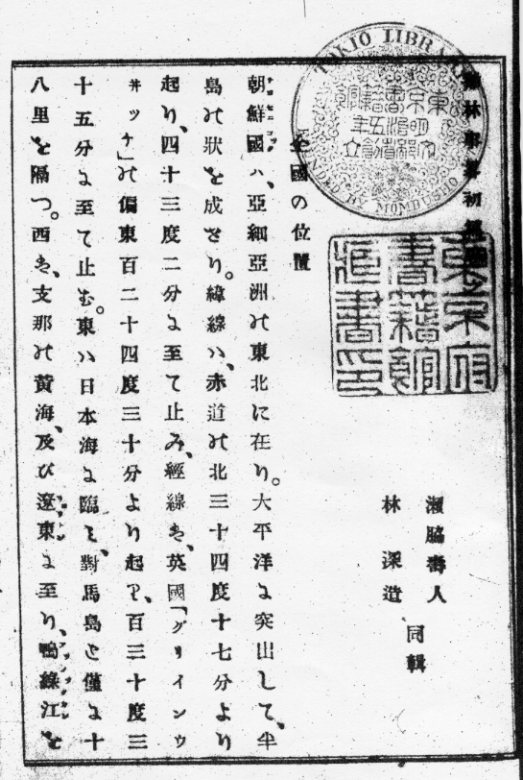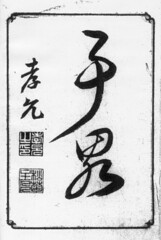 Sewaki Hisato was official of the Japanese Ministry of Foreign Affairs (MOFA) and a Dutch scholar. Later, he also became one of the first English scholars in Japan. He was stationed as the first trade secretary (practically a consul) at the Japanese trade office in Vladivostok in 1876. While there, he wrote a book entitled, "A Short Treatise on Korea" (鶏林事略), which was published in 1876 (明治九年).
Sewaki Hisato was official of the Japanese Ministry of Foreign Affairs (MOFA) and a Dutch scholar. Later, he also became one of the first English scholars in Japan. He was stationed as the first trade secretary (practically a consul) at the Japanese trade office in Vladivostok in 1876. While there, he wrote a book entitled, "A Short Treatise on Korea" (鶏林事略), which was published in 1876 (明治九年).In the book, he said that the eastern limit of Korea's border was at 130°35’E. That suggests that Sewaki believed Liancourt Rocks (Takeshima/Dokdo) to be outside Korean territory.
The following is an excerpt from the book:

朝鮮国は、亜細亜洲の東北に在り。太平洋を突出して、半島の状をなせり。緯線は、赤道の北三十四度十七分より起り、四十三度二分に至て止み、経線は、英国「グリインウヰッチ」の偏東百二十四度三十分より起り、百三十度三十五分に至て止む。
---------------------------------------
The country of Joseon is located in northeast Asia. The shape is a peninsular sticking into the Pacific Ocean. The latitude starts from 34°17’ north of the equator and stops at 43°2’. The longitude starts from 124°30’ east of Greenwich, England and stops at 130°35’.
This is the oldest Japanese book found so far to mention the latitude and longitude of Joseon Korea. Many books followed his writing style later on, but, unfortunately, there is no information on what sources Sewaki used to quote Joseon Korea's longitude and latitude.
The "Keirinjiryaku" was co-authored by Hayashi Shinzo (林深造). This is an encyclopedic book on Joseon that consists of two volumes. The first volume contains such general information as geography, customs, and population. The second volume focuses on military information.
A Mr. Kim In-seung (金麟昇) helped Hayashi by gathering and selecting Joseon books for references. Mr. Kim, who was from Gyeong-heung-bu in Joseon's Hamgyeong Province (咸鏡道慶興府) got acquainted with Sewaki in Vladivostok, but he later stayed in Tokyo with the help of  Sewaki. Interestingly, Sewaki and Kim co-authored "The Full Map of Chosun(朝鮮国全図)", which depicted Usando (于山島) to the west of Ulleungdo (鬱陵島).
Sewaki. Interestingly, Sewaki and Kim co-authored "The Full Map of Chosun(朝鮮国全図)", which depicted Usando (于山島) to the west of Ulleungdo (鬱陵島).
Sewaki is also known for having submitted, from Vladivostok, the request applications to develop Matsushima (松島), which resulted in the compilation of the "Takeshima Kosho (竹島考証)" between 1876 and 1877.
Kido Takayoshi (木戸孝允), who played a large role in the establishment of the new Meiji government, wrote the title for Sewaki's book. Mr. Kido was one of many students who had attended Sewaki 's private English school.
Pleas let me know if you find any mistakes, thank you.
ReplyDeleteWhile I was studying this book, I've learned a lot about Sewaki and found him extremely interesting. I'll summerize what I found and post it sometime soon.
Kaneganese,
ReplyDeleteI made some corrections to your post, so please recheck it for mistakes.
By the way, "Ulleungdo" is written with a "g," which, for some reason, you always drop.
Take care.
Thank you, Gerry
ReplyDeleteI honestly didn't notice that there is "g" in Ulleungdo until now. The reason is, maybe we don't have "ng" pronuciation in Japanese.
BTW, the map Sewaki and Kim draw is considered to be 1860-70. But since they got aquianted with each other after 1876 when Sewaki was dispatched to Vladivostok, the year of the map was made should be between 1876 - 1878 when Sewaki passed away from illness.
Kaneganese,
ReplyDeleteI thought you were dropping the "g" just to bug me.
By the way, that was some interesting information on Sewaki Hisato.
Yes, he is very very interesting person for me. Born in Choshu (長州) and learning English during last few decades of Edo era makes him extraordinary person. He was almost assacinated by Ito Hirobumi and others because of his Western knowledge. I was moved by the facts that so many unknown Japanese took risk of life to learn Western knowledge in order to make Japan strong and prevent from being invaded.
ReplyDeleteKaneganese,
ReplyDeleteWhat are the two grass characters on the page with Takayoshi's (孝允) name on it? Is that supposed to be the cover of Sewaki's book? I am asking because it does not look like 鷄林.
Gerry,
ReplyDeleteIt's "事略", I suppose.